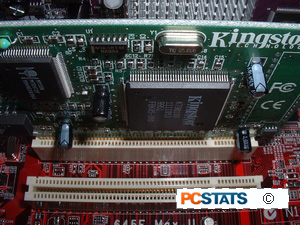Step 10: Installing PCI expansion cards
All PCI cards are physically installed the same
way. With modern motherboards, which slots you decide to use should not matter,
but it is a good idea to space your expansion cards out in order to help with
case ventilation. Simply insert the card firmly into an empty PCI slot. It
should sit evenly once inserted, with only a fraction of the gold traces on the
bottom of the card visible.

Screw the card into the expansion bracket.
Step 11: Finishing up
If your
motherboard came with any extras, such as Modem or network adaptor riser cards,
or additional USB ports on a mounting bracket, now's the time to plug them into the board (consult your
manual for the correct locations) and screw them into any free
mounting brackets you may have.
Double-check all the wiring. Make sure all connections are
firmly attached, and ensure that no wires are running close to the top of the CPU heat sink fan.
You do NOT want to jam the CPU heat sink fan,
especially with an AMD processor.
Double-check everything again. Now get
all those loose screws out.
Step 12: Powering up for the first
time
Stand the case upright, if it is not already. Ensure that no wires are touching the CPU
heat sink fan. Plug your monitor cable into the video card (VGA) port, and
turn on the monitor. Plug your PS/2 (or USB) keyboard cable into the keyboard
port. Plug in the power cord and switch the power supply switch to the on
(|) position. Press the power button. Suspense.... sparks?
If everything is connected as it should be, all system fans should start
spinning, you should hear a single beep, and after about 5-10 seconds, the amber
light on the monitor should go green, and you will see the computer start to
boot.
Depending on the manufacturer of the
Motherboard, you may get a splash screen, or just a memory check. The system
will then halt with an error because we have yet to install an operation
system. If something has gone horribly wrong, just go straight down to the troubleshooting
section. If something is on fire, go to the kitchen. You do have an extinguisher,
right?
Now check the front LEDs to see if you plugged them in correctly. Power
off and fix the LEDS because you didn't. Test the reset button. Assuming you
have got to this point without any problems, put the side panels back on,
plug in your mouse and network cables and pop your favourite operating system into
the CD drive, then power the system back up again. You are done assembling the
computer!

